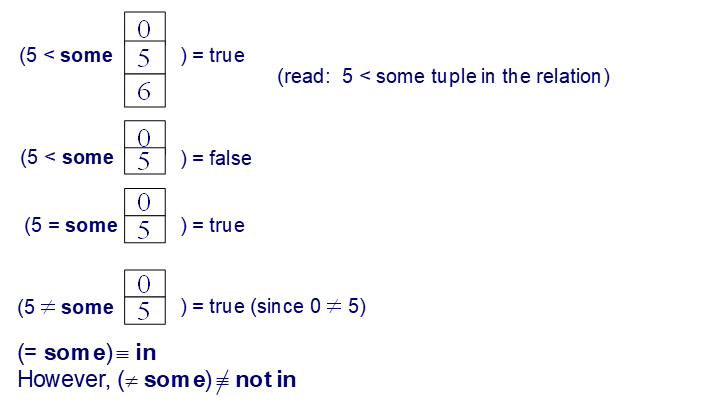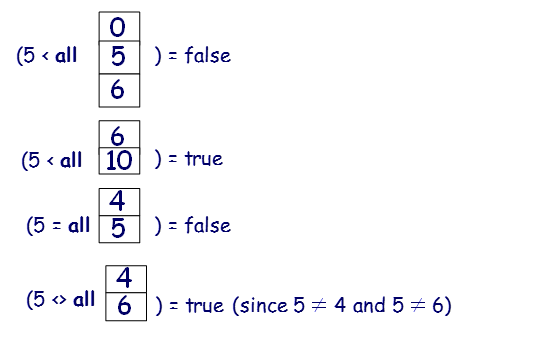2018年3月13日
11:11
写在前面
本笔记仅仅是本人在上课时的一些随手记录,并不完整也不完全正确。
如有错误,请在评论中或直接联系我指正,谢谢!
原始文件下载:(mht)(pdf)
Main contents of SQL
- Data definition
- Basic query structure
- Set operations
- Aggregate fuctions
- Null values
- Nested subqueries
- Complex queries
- Views
- Modification of the database
Nested Subqueries
- SQL提供了子查询的嵌套机制
- 子查询 (subquery)是一个 select-from where
表达式,它嵌套在另一个查询语句中 - 子查询的通常使用场合是对集合成员测试,集合比较和得出集合基数
Example Query
Find courses offered in Fall 2009 and in Spring 2010
1
2
3
4
5
6select distinct course_id
from section
where semester = 'Fall' and year = 2009 and course_id in
(select course_id
from section
where semester = 'Spring' and year = 2010);
Find courses offered in Fall 2009 but not in Spring 2010
2
3
4
5
6
7
from section
where semester = 'Fall' and year = 2009 and course_id not
in
(select course_id
from section
where semester = 'Spring' and year = 2010);Find the total number of (distinct) students who have taken course sections taught by the instructor with ID 10101
2
3
4
5
6
from takes
where (course_id, sec_id, semester, year) in
(select course_id, sec_id, semester, year
from teaches
where teaches.ID = 10101);
- 注意:上述查询语句可以大幅简化。上述式子仅仅是为了表现SQL的特性而已。
Set Comparison
Find names of instructors with salary greater than that of some (at least one) instrutor in the Biology department
1
2
3select distinct T.name
from instructor as T, instructor as S
where T.salary > S.salary and S.dept_name = 'Biology';
Same query using > some clause
2
3
4
5
6
from instructor
where salary > some
(select salary
from instructor
where dept_name = 'Biology');
Definition of Some Clause

Test for Empty Relations
- The exists construct returns the value true if the argument subquery is nonempty
- exists r ⇔ r ≠ Ø
not exists r ⇔ r = Ø
Application:
- Note that X – Y = Ø ⇔ X ⊆ Y
- not exists (X except Y) ⇔ X ⊆ Y
Correlation Variables
E.g. Yet another way of specifying the query “Find all courses taught in both the Fall 2009 semester and in the Spring 2010 semester”1
2
3
4
5
6
7select course_id,
from section as S,
where semester = 'Fall' and year = 2009 and
exists (select *,
from section as T,
where semester = 'Spring' and year = 2010
and S.course_id = T.course_id);
Correlated subquery
- Correlation name or correlation variable
Not Exists
e.g. Find all students who have taken all courses offered in the Biology department
1
2
3
4
5
6
7
8
9select distinct S.ID, S.name,
from student as S,
where not exists ((select course_id,
from course,
where dept_name = 'Biology')
except
(select T.course_id,
from takes as T,
where S.ID = T.ID));

Test for Absence of Duplicate Tuples
- The unique construct tests whether a subquery has any duplicate tuples in
its result.- (Evaluates to “true” on an empty set)
e.g. Find all courses that were offered at most once in 2009
1
2
3
4
5
6select T.course_id,
from course as T,
where unique (select R.course_id,
from section as R,
where T.course_id = R.course_id
and R.year = 2009);
- (Evaluates to “true” on an empty set)
Subqueries in the From Clause
- SQL允许在From语句中使用子查询表达式
e.g. Find the average instructors’ salaries of those departments where the average salary is greater than $42,000
1
2
3
4
5select dept_name, avg_salary
from (select dept_name, avg (salary) as avg_salary,
from instructor,
group by dept_name)
where avg_salary \> 42000;
- 注意:这里我们不需要使用having语句
- 上述查询的另一种表述方式:
2
3
4
5
6
from (select dept_name, avg (salary),
from instructor,
group by dept_name)
as dept_avg(dept_name, avg_salary)
where avg_salary > 42000;
- 还有一种:
1
2
3
4
5
6
7
8
9
10
11
12
13
14
15
16
17
18
19select name, salary, avg_salary
from instructor I1,
lateral (select avg(salary) as avg salary,
from instructor I2,
where I2.dept_name = I1.dept_name);
```
- Lateral语句允许from语句后面部分(在**lateral**关键词后)获取前面部分的关联变量
- 注意:Lateral语句是SQL标准的一部分,但是在许多DBS中是不被支持的;一些DB,例如SQL Server,提供了一些替代语法
#### *With Clause*
- with语句提供了定义临时view的方法 这个定义只有在有with语句的查询语句才会生效
> **e.g. Find all departments with the maximum budget**
> ```SQL
with max_budget(value) as
(select max(budget)
from department)
select budget
from department, max_budget
where department.budget = max_budget.value;
Complex Queries
Complex Queries using With Clause
- with语句在写复杂查询语句时十分有用
- with语句被大多数DBS所支持,当然会有一些语法上的区别
e.g. Find all departments where the total salary is greater than the average of the total salary at all departments
1
2
3
4
5
6
7
8
9
10
11with dept_total(dept_name, value)as
(select dept_name, sum(salary)
from instructor
group by dept_name),
dept_total_avg(value) as
(select avg(value)
from dept_total)
>
select dept_name,
from dept_total, dept_total_avg
where dept_total.value >= dept_total_avg.value
Scalar Subquery
- 标量子查询是对单值的查询
e.g.
1
2
3
4
5
6
7
8
9
10
11
12select dept_name,
(select count(\*),
from instructor,
where department.dept_name = instructor.dept_name)
as num_instructors
from department;
>
select name,
from instructor,
where salary*10 >
(select budget from department
where department.dept_name = instructor.dept_name)
Modification of the Database
Deletion
Delete all instructors
Delete all instructors from the Finance department
2
where dept_name= 'Finance';Delete all tuples in the instructor relation for those instructors associated with a department located in the Watson building.
2
3
4
where dept_name in (select dept_name
from department
where building = 'Watson');Delete all instructors whose salary is less than the average salary of instructors
2
where salary< (select avg (salary) from instructor);
- 问题:如果我们从deposit中删除元组,那么平均工资的值是会变化的
在SQL中的解决方案:
- 首先算出平均工资,并找到所有要删除的元组
- 之后删除之前找到的元组(并不会重新计算或重新测试元组)
Insertion
Add a new tuple to course
2
values ('CS-437', 'Database Systems', 'Comp. Sci.', 4);Or equivalently
2
values ('CS-437', 'Database Systems', 'Comp. Sci.', 4)Add a new tuple to student with tot_creds set to null
2
values ('3003', 'Green', 'Finance', null);Add all instructors to the student relation with tot_creds set to 0
2
3
select ID, name, dept_name, 0
from instructor
- Select from where 语句会在它导致的任何结果插入这个关系之前计算结果
不然的话例如1
insert into table1 select * from table1
如果table1没有定义任何主码,那就会出现问题
Updates
Increase salaries of instructors whose salary is over \$100,000 by 3%, and all others receive a 5% raise
- Write two update statements
1
2
3
4
5
6
7update instructor
set salary = salary * 1.03
where salary > 100000;
>
update instructor
set salary = salary * 1.05
where salary <= 100000;
- Write two update statements
顺序十分重要
- 上述语句可以使用case语句更好实现
Case Statement for Conditional Updates
- 之前语句的case版本
1
2
3
4
5
6
7
8
9
10
11
12
13
14
15update instructor
set salary = case
when salary <= 100000 then salary * 1.05
else salary * 1.03
end
```
#### *Updates with Scalar Subqueries*
> - **Recompute and update tot_creds value for all students**
> ```SQL
update student S
set tot_cred = (select sum(credits)
from takes natural join course
where S.ID = takes.ID and
takes.grade \<\> 'F' and
takes.grade is not null);
- Sets tot_creds to null for students who have not taken any course
- 除了sum(credits)之外,可以使用:
case when sum(credits) is not null then sum(credits) else 0 end

